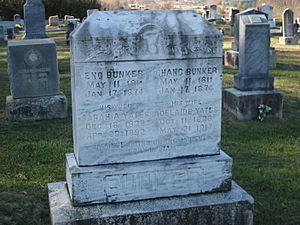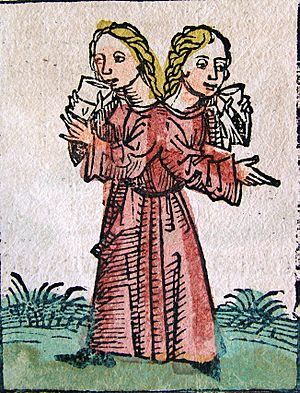Conjoined twins facts for kids
Conjoined twins are identical twins who are joined together before birth. This is a very rare event, happening in about 1 out of every 49,000 to 189,000 births. It's seen a bit more often in Southeast Asia and Africa. Sadly, about half of conjoined twins are stillborn, and another third pass away within 24 hours of being born. Most conjoined twins who are born alive are girls, with about three girls for every boy.
There are two main ideas about how conjoined twins form. The most accepted idea is called fission. This means that a fertilized egg starts to split to form identical twins, but it doesn't fully separate. The other idea, which isn't widely believed anymore, is called fusion. This theory suggested that two fully separated identical twins somehow joined back together. Conjoined twins usually share one placenta and amniotic sac inside the mother, but it's important to know that some identical twins who are not conjoined can also share these structures.
The most famous conjoined twins were Chang and Eng Bunker (1811–1874). They were brothers born in Siam, which is now Thailand. They became very well-known by traveling with P. T. Barnum's circus and were called the Siamese twins. Chang and Eng were connected at their chest by a band of flesh, cartilage, and their livers. Today, doctors could likely separate them easily. Because of their fame and how rare their condition was, the term "Siamese twins" became another way to say "conjoined twins."
Separating Conjoined Twins
Surgery to separate conjoined twins can be very different for each pair. It depends on where they are joined and which internal body parts they share. Many separation surgeries are very risky and can be life-threatening. In some cases, one or both twins might not survive the surgery, especially if they are joined at the head or share a vital organ like the heart.
A Look Back: History of Conjoined Twins
People have known about conjoined twins for a very long time. The Moche culture in ancient Peru created art showing conjoined twins as far back as 300 CE. The first known written record of conjoined twins is from the year 942. This was when two conjoined twin brothers from Armenia were taken to Constantinople for doctors to examine them.
The English twin sisters Mary and Eliza Chulkhurst are one of the earliest well-known examples. They were joined at their backs and lived from 1100 to 1134 (or possibly 1500 to 1534). Other early conjoined twins who gained attention included the "Scottish brothers" and Helen and Judith of Szőny, Hungary (1701–1723). Helen and Judith were also joined at their backs. They had a short career in music before living in a convent. Rita and Cristina of Parodi from Sardinia, born in 1829, shared one body with four arms. They lived for only eight months but became famous when their parents showed them in Paris.

During the 1800s, several sets of conjoined twins became performers. However, none became as famous or wealthy as Chang and Eng. One notable pair was Millie and Christine McKoy (or McKoy), who were born into slavery in North Carolina in 1851. They were joined at their backs. They were sold to a showman, J.P. Smith, at birth. Later, a rival showman kidnapped them and took them to England. But England had already banned slavery, so the kidnapper's plan failed. Smith traveled to England to get the girls back and brought their mother, Monimia, who had been separated from them. Smith and his wife made sure the twins got an education. They taught them to speak five languages, play music, and sing. For the rest of the century, the twins had a very successful career as "The Two-Headed Nightingale" and performed with the Barnum Circus. In 1912, they passed away from tuberculosis, just 17 hours apart.
Giovanni and Giacomo Tocci, from Locana, Italy, were born in 1877. They had one body with two legs, but two heads and four arms. Their story was even featured in Mark Twain's short story "Those Extraordinary Twins." From birth, their parents made them perform. It is said they did not like being in show business. In 1886, after touring the United States, the twins and their family returned to Europe and became very ill. It is believed they passed away around this time, though some sources say they lived quietly in Italy until 1940.
See also
 In Spanish: Siameses para niños
In Spanish: Siameses para niños



